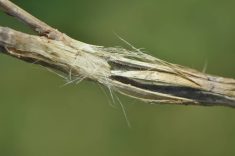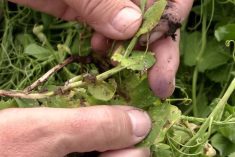There’s little point spraying canola at 50 per cent bloom or later for protection against sclerotinia, says a plant pathologist with Manitoba Agriculture, Food and Rural Initiatives.
“You may see a visual difference (less disease) but there won’t be a yield difference,” said Holly Derksen.
If conditions warrant, the ideal time to apply a fungicide is at 20 to 30 per cent bloom. The right conditions include the presence of apothecia (the small mushroom-like structure that spew disease spores), high in-crop moisture, and moderate growing temperatures. If it’s dry and hot — 30 C or warmer, the sclerotinia risk is reduced.
Read Also

Thunderstorms and straight-line winds
Straight-line winds in thunderstorms can cause as much damage as a tornado and are next on our weather school list exploring how and why severe summer weather forms.
Many farmers in Manitoba’s Red River Valley routinely spray because sclerotinia is ubiquitous and weather conditions are usually right for the disease. A lot of that spraying has already occurred, Derksen said.
However, in western Manitoba many canola crops are just coming into the right stage for spraying.
Farmers can assess their canola fields’ moisture while scouting for apothecia. If your pant legs are wet after walking through the crop at 9 a.m., then there’s probably enough moisture for the disease to grow. If the farmer gets wet walking the crop in the afternoon there’s almost certainly enough moisture for the disease.
Finding apothecia adds to the risk, but not finding them doesn’t eliminate the risk, said Kelly Turkington, with Agriculture and Agri-Food Canada in Lacombe, Alta.
Apothecia could be in part of the field that wasn’t checked, and can also be present in adjacent fields — even if not seeded to canola.
When in doubt, consider a split application, but only if the fungicide is registered for that, Turkington said during a webinar sponsored by the Canola Council of Canada. When spraying the same field a second time, a different group should be used to delay the onset of fungicide resistance, he added. Cases of sclerotinia resistance to benomyl (Benolate) have been detected in Western Canada, Turkington said.
In most cases, a properly staged and applied application is sufficient, said Derksen.
Some canolas are sclerotinia tolerant, but none are currently resistant, Turkington said. Those varieties should be sprayed with a fungicide when exposed to a lot of disease under conducive weather conditions, he said.
Sclerotinia-resistant canola is the “Holy Grail” and Agriculture Canada is making progress — such varieties could be available in five to 10 years, Turkington said.
In the meantime, he recommends an integrated approach to control, including good seed, fertility and proper seeding depth. Some varieties are more subject to lodging and lodged crops can harbour more moisture and the disease can spread faster.
With sclerotinia so prevalent in Manitoba, including in some weeds, crop rotation alone cannot usually prevent it.
Pedal kits are available to help farmers assess their crop’s risk to sclerotinia.
The canola council also had a photographic guide and checklist farmers can download and use in the field to assess the risk. It’s available at: https://canola-council.merchantsecure.com/canola_resources/product11.aspx.



















